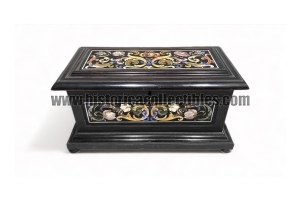Casket in rosewood, ebony and stones from the "Botteghe Granducali Fiorentine", circa 1685
Casket or jewelery box in ebony and rosewood, with black marble panels inlaid with precious varieties of semiprecious stones (Florentine clerk) made in the Gallery of Works of the Opificio delle Pietre Dure (Botteghe Granducali Fiorentine) of Florence in a period included between approximately 1685 and 1700.
In its rectangular wooden structure, five black marble panels are set and decorated inside refined bronze frames, two front-back, two on the sides and one on the lid under which a geometric decoration composed from threaded light rosewood plates with ebony inlay. The marble panels are admirably inlaid with precious varieties of semi-precious stones elaborated to form various species of flowers including roses, tulips, cornflowers and scrolled acanthus leaves, characteristic of the designs of Giovanni Battista Foggini (Florence 1652-1725), one of the most illustrious Italian architects and sculptors of the Baroque artistic period who, in the service of the de Medici family under the Grand Duke Cosimo III, was from 1685 enthusiastic artistic director of the Gallery of Works of the Opificio delle Pietre Dure (Grand Ducal Workshops) where he supervised every detail of the works produced in them.
The set of elements that form the Casket, such as wood, iron, bronze and inlaid marble, are irrefutably contemporary and their manufacturing is attributed to the renowned workers who worked in the Gallery of Works of the Opificio delle Pietre Dure in Florence as they exactly identify the Jewelry Boxes in precious woods and part of a whole series of hard stone inlays that were designed by G.B. Foggini. About four hundred of these drawings are preserved in the Cabinet of Drawings and Prints of the Uffizi, while a smaller group of twenty-five is part of the Corsini Fund of the National Cabinet of Drawings and Prints in Rome; still other sheets are found scattered among Florentine offices and other European cities as well as being present in the most important specialized publications.
The execution of the marble and semi-precious stone panels present on this casket, having seen and compared the corresponding executive stylistic dictates in other works present in the Museum of the Opificio delle Pietre Dure in Florence, can be traced back to the Maestranza of Antonio Cappelli in 1685.
Extraordinary and historic Casket, of magnificent executive quality which places it among the most important and significant testimonies of the taste and refinement produced in the Gallery of Works of the Opificio delle Pietre Dure (Grand Ducal Workshops) of Florence between the 17th and 18th centuries.
The chest is in excellent condition and free of restorations, furthermore there is the original lock with its key, perfectly functional.
Note of curiosity:
The most prestigious caskets or jewelery boxes were made as gifts for members of the Grand Ducal Family, and some of these, which the Grand Duke often donated, contained particularly rare essences or medicines, distilled in his shops, or as furnishing commissions for their residences. In some cases they were sent as Diplomatic gifts to foreign Princes or eminent Courtiers; Fascinating objects of precious character whose beauty was reserved for high-ranking amateurs, very rarely were the objects sold to the public and, when they were, they would be exceptions and consisting of small objects.
These sophisticated gifts often contained essences and medicines with the most unusual and evocative names, such as "fiery ointment", "amber essence" or "jasmine balm". All this is amply confirmed by a chest from the collection of the Principi Corsini family in Florence, created in 1720 based on a design by Giovan Battista Foggini.
Gallery of Works, Florence
The Galleria dei Lavori was founded in Florence at the end of the sixteenth century under Grand Duke Ferdinand I. It owes its name to the series of rooms in which it was located on the first floor of the same building as the Uffizi Gallery and where its work continued until the early of the nineteenth century when the business was moved to a large building near the Academy of Fine Arts. It is still there today although it is now known as the Opificio delle Pietre Dure and conservation constitutes the bulk of its work.
The Gallery of Works consisted of a series of studios or workshops for carpenters, cabinetmakers, wood carvers, goldsmiths, designers, founders, metalworkers, gilders of various kinds and the hard stone carvers (or commettitori) who carried out the intricate work to 'fit' semi-precious stones and marble (soft stones) compositions, as well as many other craftsmen from all over Europe. At the time of the creation of this object the workshops were under the artistic direction of the Florentine sculptor Giovanni Battista Foggini (1652-1725) who was appointed around 1685, although for several years he had been sculptor and court architect of the Medici. The main objects produced in the Gallery of Works were table tops with bases made mainly of ebony, rosewood and gilt bronze. There were also caskets, reliquaries and devotional objects of various kinds, various cabinets and cabinets and more rarely, trays and frames.
REFERENCE BIBLIOGRAPHY:
A. Gonzàlez-Palacios, Il Tempio del Gusto, La Toscana e l’Italia settentrionale, Milano 1986, vol. II, p. 83, fig. 80;A. González-Palacios, Il Tempio del Gusto: La Toscana e L'Italia Settentrionale, Milan, 1984, vol. I, p. 43, and vol. II, p. 60, fig. 74
Alvar González-Palacios, Il Tempio del Gusto, Vol. II, Milan, 1986, pp. 60-62.
A. Giusti, Pietre Dure, Torino 1992, p. 110, fig. 28;
A. Gonzàlez-Palacios, Las Colecciones Reales Españolas de Mosaicos y Piedras Duras, Madrid 2001, pp. 114-115, n. 20;
A. Giusti, La Fabbrica delle Meraviglie. La Manifattura di Pietre Dure a Firenze, Firenze 2015, p. 43, figg. 54-55.
Anna Maria Giusti, Paolo Mazzoni, Annapaula Pampaloni Martelli, Il Museo Dell`Opificio Delle Pietre Dure a Firenze, 1978, pl. 146-153.


